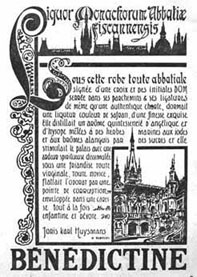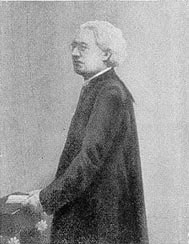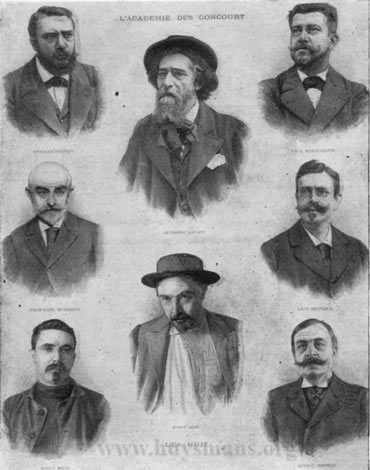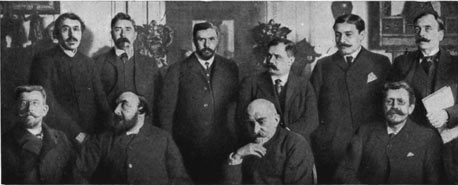Chronology

Perhaps the best complete biography of Huysmans is Robert Baldick’s The Life of J.-K. Huysmans. The book was originally published in English by the Clarendon Press in 1955 — a new revised edition is now available from Dedalus Books — and there have been two French editions published by Editions Denoël, in 1958 and 1975. Below is a brief chronology of Huysmans’ life and work.
1848. Born Charles-Marie-Georges Huysmans on 5th February.
1856. His father, Godfried Huysmans dies on 24th June. Soon after, his widow, Malvina takes the family to live at her parents, at No.11 Rue de Sèvres. Huysmans begins studying at the Institution Hortus, at No. 94 Rue du Bac.
1857. Malvina remarries a Protestant businessman, Jules Og.
1866. On 7th March, Huysmans obtains his Baccalaureate. On 1st April, Huysmans begins work as an employé de sixième classe at the ministère de l’Intérieur et des Cultes.
1867. Publishes his first article on 27th November, a piece entitled ’Des paysagistes contemporains’ in La Revue Mensuelle.
 |
|
J.-K. Huysmans |
1874. Publishes his first collection of poems in prose, Le Drageoir à épices, at his own expense, under the name by which he is now known, Joris-Karl Huysmans. The following year the book was republished under the title Le Drageoir aux épices.
1876. Publishes his first novel, Marthe, histoire d’une fille.
1877. Publishes four articles in the Brussels-based magazine L’Actualité under the title ’Emile Zola et L’Assommoir’. In them, Huysmans presents Zola as a model writer, almost as a typical bourgeois, and defends his right to treat all aspects of modern life in his books.
1879. Publishes his second novel, Les Soeurs Vatard.
1880. Publication of ’Sac au dos’ in Les Soirées de Médan. Publication of Croquis parisiens.
1881. Suffering from nervous exhaustion and neuralgia, Huysmans stays at Fontenay-aux-Roses to convalesce. The house would be the model for that of des Esseintes in A rebours.
1884. Publishes A rebours, the book which Arthur Symons described as the ’breviary of the Decadence’.
1885.
August. Travels to Lourps with Anna Meunier and her two daughters. Lourps was to be the rural setting for his next novel En Rade.
The printing works which he had inherited from his step-father in financial difficulties.
1886. Publication of revised and expanded edition of Croquis parisiens. Huysmans again goes to Lourps during August and September.
1887. Publishes En Rade.

1888. Huysmans is invited to Hamburg by his friend Arij Prins. He travels to Germany and sees for the first time Matthias Grunwald’s Crucifixion at the Cassel museum, which he was later to describe in Là-bas.
1889. Remy de Gourmont introduces his mistress, Berthe Courrière to Huysmans. Previously, she had been the mistress and model of the sculptor Ernest Clésinger. She helped instruct Huysmans in the occult arts and was one of the women on whom he modelled Hyacinthe Chantelouve in Là-bas. The other, Henriette Maillat, seemed to specialise in taking literary lovers, numbering Sar Péladan and Léon Bloy among her conquests. Maillat first made contact with Huysmans in 1887, through an anonymous letter, and they conducted a brief affair in 1888. Huysmans later copied out Maillat’s letters to him before returning them and used them, almost word for word in Là-bas, in which Madame Chantelouve attempts to seduce Durtal by similar means.
September 2-12. Researching Là-bas, Huysmans visits Chateau Tiffauges, the site of Gilles de Rais’ massacres, in the company of Francis Poictevin.
November. Publication of Certains, which featured essays on painters such as Forain, Gustave Moreau and Felicien Rops.
1890. Publication of La Bièvre. Huysmans also makes his first contacts with ex-Abbé Boullan, whom he portrays in Là-bas as the Doctor Johannès.

|
Abbé Louis van Haecke, the priest who was reputedly the model for the Satanic Canon Docre in Là-Bas. |
1891. Là-bas is serialised in L’Echo de Paris. It is published in book form in April. Perhaps because of its controversial subject matter, but also because it managed to capture the mood of the times, the Là-Bas became Huysmans first major best-selling novel.
On May 28, Berthe Courrière introduces Huysmans to the Abbé Mugnier, who was later to become his spiritual director.
1893. In April, Huysmans had to hospitalise his long-standing mistress, whom he had portrayed in a number of novels, in the Sainte-Anne asylum.
September 3rd. Huysmans awarded the Legion d’honneur for his work in the civil service.
1895. February 12th. Death of Anna Meunier.
Publication of En Route, the ’white book’ which Huysmans wrote in reaction to the ’black book’, Là-Bas. It recounts Durtal’s retreat to a Trappist monastery and is the first of Huysmans’ overtly Catholic books.
Publication of Jules Bois’ Le Satanisme et la magie, which included a Preface by Huysmans.
1896. Death of two long-time friends of Huysmans, Paul Verlaine and Edmond de Goncourt. As one of the executors of Goncourt’s will, Huysmans carried out its instructions which included setting up the eponymous Académie Goncourt, of which Huysmans was the first president.

|
|
Members of the |
1898. Publication of La Cathédrale.
Huysmans retires from the civil service after over thirty years.
1900. On April 6th, Huysmans arrived in Paris, after obtaining permission from the Prior of Ligugé, where he was staying at the time, to attend a meeting of the Académie Goncourt. The next day, in Léon Hennique’s flat in the Rue Descamps, Elémir Bourges, Léon Daudet and Lucien Descaves were elected, to make the number of academicians up the required number, ten, and Huysmans himself, as the eldest, became its first President.
1901. March 21st. Huysmans undergoes ceremony of oblatehood at Ligugè.
In September, Huysmans returns to Paris from Ligugè, and moves into 20, Rue Monsieur.
October 1st. Publication of Sainte Lydwine de Schiedam.
November. Publication of De Tout.
1902. The first signs of the cancer that was eventually to cause his death.

|
|
The Académie Goncourt in 1903 |
1903.
January. Although the validity of Edmund de Goncourt’s will was established in 1900, the Académie Goncourt was not legally recognised as it had to conform to the provisions of the Law on Associations. On January 19th 1903, Emile Combes signed the offical decree granting it authorisation and recognising its "public utility".
March 2nd. Huysmans sends out review copies of L’Oblat.
March 5th. Travelled to Lourdes, where he remained until April 1st making notes for his book. Huysmans was not particularly impressed by what he saw. He was later to describe the church of the Rosary as a "plethora of vileness" and a "haemorrhage of bad taste."
September. Travels to Germany and Belgium with the Abbé Mugnier.

|
|
An example of Huysmans’ signature. |
1904. Moves into 31, rue Sainte-Placide on March 1st. It was to be his last address.
1906.
October. Publication of Les foules de Lourdes.
November 8th. Huysmans makes out his will, bequeathing the royalties from his works to his two half-sisters, and appointing Lucien Descaves as his executor.
November 24th. Cancer is discovered during an operation on Huysmans’ mouth.
1907.
January 13th. Huysmans promoted to the rank of Officier de la Légion d’Honneur.
May 12th. Death of Huysmans.
May 15th. Huysmans’ funeral at Notre-Dame-des-Champs, where the Requiem mass was celebrated by the Abbé Mugnier. A huge crowd followed Huysmans’ bier through the streets to Montparnasse Cemetery, where he was buried in the family grave.
1908. Posthumous publication of Trois églises et trois primitifs, under the direction of Lucien Descaves.